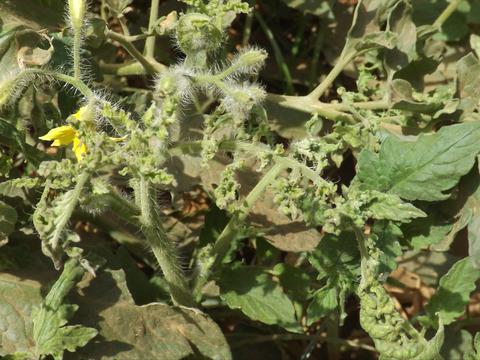当前位置:
X-MOL 学术
›
Plant Pathol.
›
论文详情
Our official English website, www.x-mol.net, welcomes your
feedback! (Note: you will need to create a separate account there.)
Diversity, distribution and prevalence of vegetable‐infecting geminiviruses in Burkina Faso
Plant Pathology ( IF 2.3 ) Pub Date : 2019-12-01 , DOI: 10.1111/ppa.13120 A. Ouattara 1, 2, 3, 4, 5 , F. Tiendrébéogo 1, 5 , P. Lefeuvre 2 , M. Hoareau 2 , S. Claverie 2, 3 , A. Allibert 2 , F. Chiroleu 2 , E.V. Traoré 1, 5 , N. Barro 4 , O. Traoré 1, 5, 6 , J.‐M. Lett 2
Plant Pathology ( IF 2.3 ) Pub Date : 2019-12-01 , DOI: 10.1111/ppa.13120 A. Ouattara 1, 2, 3, 4, 5 , F. Tiendrébéogo 1, 5 , P. Lefeuvre 2 , M. Hoareau 2 , S. Claverie 2, 3 , A. Allibert 2 , F. Chiroleu 2 , E.V. Traoré 1, 5 , N. Barro 4 , O. Traoré 1, 5, 6 , J.‐M. Lett 2
Affiliation

|
In West and Central Africa, as in many regions of the world, vegetables are severely affected by geminivirus diseases. In Burkina Faso, observation of various virus‐like symptoms, especially on tomato, suggests the involvement of several geminiviruses and underlines the pressing need for additional information on their diversity, distribution, prevalence and host plant reservoirs. Large‐scale surveys conducted in Burkina Faso confirmed the presence of tomato (yellow) leaf curl diseases (ToLCD‐TYLCD) and geminiviruses in all localities with mean prevalences of 25% and 45%, respectively. Five geminiviruses including four begomoviruses (pepper yellow vein Mali virus (PepYVMLV), tomato leaf curl Burkina Faso virus, tomato leaf curl Mali virus and tomato leaf curl Ghana virus) and a dicot‐infecting mastrevirus (chickpea chlorotic dwarf virus) were characterized on tomato. In addition, PepYVMLV and cotton leaf curl Gezira virus (CLCuGeV) were characterized on pepper and okra, respectively, in combination or not with alphasatellites and betasatellites for CLCuGeV. The most severe, prevalent and widely distributed virus on vegetables was PepYVMLV, which was characterized for the first time in combination with a genetically divergent DNA‐B component that may constitute a key factor of PepYVMLV pathogenicity. Of the eight weeds identified as potential reservoir hosts of begomoviruses, four host PepYVMLV. The results confirm the importance of geminivirus diseases on vegetable crops in Burkina Faso and highlight the complex association of geminiviruses and satellites. The detection of begomoviruses in weeds growing close to crops points to the increasing necessity to consider reservoir plants and virus communities in the control of virus diseases.
中文翻译:

布基纳法索植物感染双生病毒的多样性、分布和流行
在西非和中非,与世界许多地区一样,蔬菜受到双生病毒病的严重影响。在布基纳法索,观察到各种病毒样症状,尤其是在番茄上,表明涉及几种双生病毒,并强调迫切需要有关其多样性、分布、流行和宿主植物宿主的更多信息。在布基纳法索进行的大规模调查证实,所有地区都存在番茄(黄色)卷叶病 (ToLCD-TYLCD) 和双生病毒,平均患病率分别为 25% 和 45%。五种双生病毒,包括四种贝戈莫病毒(辣椒黄脉马里病毒(PepYVMLV)、番茄卷叶布基纳法索病毒、番茄卷叶马里病毒和番茄卷叶加纳病毒)和双子叶植物感染的母体病毒(鹰嘴豆褪绿矮病毒)在番茄上进行了表征。此外,PepYVMLV 和棉花卷叶 Gezira 病毒 (CLCuGeV) 分别在胡椒和秋葵上与 CLCuGeV 的 alphasatellites 和 betasatellites 结合或不结合进行了表征。蔬菜上最严重、最普遍和最广泛分布的病毒是 PepYVMLV,它首次与基因上不同的 DNA-B 组分结合进行表征,该组分可能构成 PepYVMLV 致病性的关键因素。在被确定为 begomoviruses 潜在宿主宿主的八种杂草中,四种宿主 PepYVMLV。结果证实了双生病毒病对布基纳法索蔬菜作物的重要性,并强调了双生病毒和卫星之间的复杂关联。在作物附近生长的杂草中检测到 begomoviruses 表明在控制病毒病害时考虑水库植物和病毒群落的必要性越来越大。
更新日期:2019-12-01
中文翻译:

布基纳法索植物感染双生病毒的多样性、分布和流行
在西非和中非,与世界许多地区一样,蔬菜受到双生病毒病的严重影响。在布基纳法索,观察到各种病毒样症状,尤其是在番茄上,表明涉及几种双生病毒,并强调迫切需要有关其多样性、分布、流行和宿主植物宿主的更多信息。在布基纳法索进行的大规模调查证实,所有地区都存在番茄(黄色)卷叶病 (ToLCD-TYLCD) 和双生病毒,平均患病率分别为 25% 和 45%。五种双生病毒,包括四种贝戈莫病毒(辣椒黄脉马里病毒(PepYVMLV)、番茄卷叶布基纳法索病毒、番茄卷叶马里病毒和番茄卷叶加纳病毒)和双子叶植物感染的母体病毒(鹰嘴豆褪绿矮病毒)在番茄上进行了表征。此外,PepYVMLV 和棉花卷叶 Gezira 病毒 (CLCuGeV) 分别在胡椒和秋葵上与 CLCuGeV 的 alphasatellites 和 betasatellites 结合或不结合进行了表征。蔬菜上最严重、最普遍和最广泛分布的病毒是 PepYVMLV,它首次与基因上不同的 DNA-B 组分结合进行表征,该组分可能构成 PepYVMLV 致病性的关键因素。在被确定为 begomoviruses 潜在宿主宿主的八种杂草中,四种宿主 PepYVMLV。结果证实了双生病毒病对布基纳法索蔬菜作物的重要性,并强调了双生病毒和卫星之间的复杂关联。在作物附近生长的杂草中检测到 begomoviruses 表明在控制病毒病害时考虑水库植物和病毒群落的必要性越来越大。











































 京公网安备 11010802027423号
京公网安备 11010802027423号